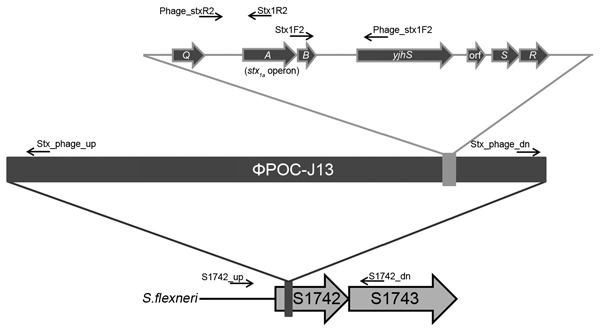Volume 20, Number 10—October 2014
Research
Clinical Isolates of Shiga Toxin 1a–Producing Shigella flexneri with an Epidemiological Link to Recent Travel to Hispañiola
Figure 4

Figure 4. Schematic of PCR designed to determine that Shiga toxin 1a gene (stx1a) is phage encoded and inserted into the S1742 locus of Shigella flexneri. The genetic map shows the insertion of ϕPOC-J13 into locus S1742 of stx1a-encoding S. flexneri. Location and direction of the primers used for PCR analyses are indicated. The top part of the figure indicates the genes flanking the stx1a operon. Q, antiterminator; A and B, Stx1a subunits that form the assembled toxin (A is the stx1aA subunit and B is the stx1aB subunit); yshS, a hypothetical protein that shares homology with yjhS from Escherichia coli K-12; orf, open reading frame; S, gene that encodes the phage holin; R, gene that encodes the phage endolysin.
Page created: September 12, 2014
Page updated: September 12, 2014
Page reviewed: September 12, 2014
The conclusions, findings, and opinions expressed by authors contributing to this journal do not necessarily reflect the official position of the U.S. Department of Health and Human Services, the Public Health Service, the Centers for Disease Control and Prevention, or the authors' affiliated institutions. Use of trade names is for identification only and does not imply endorsement by any of the groups named above.